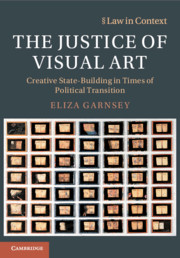Book contents
- The Justice of Visual Art
- The Law in Context Series
- The Justice of Visual Art
- Copyright page
- Dedication
- Contents
- Figures
- Acknowledgements
- Abbreviations
- 1 Introduction
- 2 Art and Justice in Times of Transition
- Part I Recognising Transitional Justice in the Nation State
- 3 From Prison to Court
- 4 Shaping ‘Legal’ Space
- 5 The Art of Recognition
- 6 The Visual Jurisprudence of Transition
- Part II Representing Transitional Justice on the Global Stage
- References
- Index
6 - The Visual Jurisprudence of Transition
from Part I - Recognising Transitional Justice in the Nation State
Published online by Cambridge University Press: 17 October 2019
- The Justice of Visual Art
- The Law in Context Series
- The Justice of Visual Art
- Copyright page
- Dedication
- Contents
- Figures
- Acknowledgements
- Abbreviations
- 1 Introduction
- 2 Art and Justice in Times of Transition
- Part I Recognising Transitional Justice in the Nation State
- 3 From Prison to Court
- 4 Shaping ‘Legal’ Space
- 5 The Art of Recognition
- 6 The Visual Jurisprudence of Transition
- Part II Representing Transitional Justice on the Global Stage
- References
- Index
Summary
Chapter 6, The Visual Jurisprudence of Transition, theorises the Constitutional Court of South Africa’s art collection as a new kind of visual jurisprudence—the philosophy of the visual in law.I analyse the ways in which people, especially judges, talk about the art collection in order to show how artworks at the Court become central to the bodies of aesthetic knowledge that shape the appearance of justice and that shape how justice is understood. I argue that the artworks at the Court engage the moral imagination—a position which intersects with the debate in human rights scholarship over whether moral discourse or sentimental education is more effective in promoting respect for rights. In such close proximity to the Court, the art collection inhabits a unique position in which the assumptions of justice (and Justices) and what it means to uphold the Constitution can be probed.This creates a visual jurisprudence that reflects both the values which underpin the Court as well as the ways of practicing justice in post-apartheid South Africa.
Keywords
- Type
- Chapter
- Information
- The Justice of Visual ArtCreative State-Building in Times of Political Transition, pp. 113 - 126Publisher: Cambridge University PressPrint publication year: 2019

